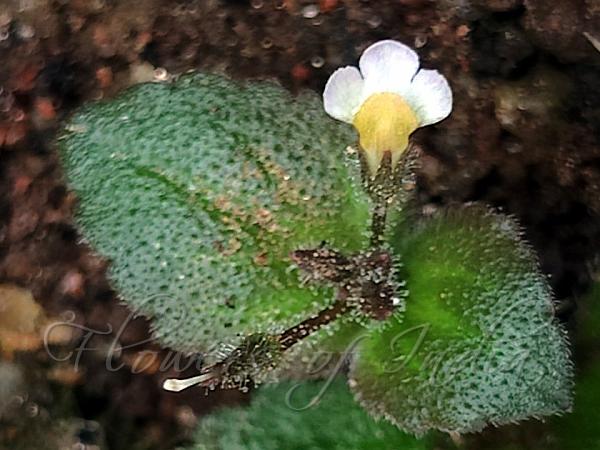|
| Spreading Lindernia |
|

|

|
|
|
|
Photo: |
Botanical name: Vandellia diffusa Family: Linderniaceae (Lindernia family)
Synonyms: Lindernia diffusa, Riedelia officinalis, Pyxidaria diffusa
Synonyms: Lindernia diffusa, Riedelia officinalis, Pyxidaria diffusa
Spreading Linderniais an annual spreading or creeping
herb, spreads up to 30 cm long, rooting at the nodes. Stem is 4-angled,
velvet-hairy, hairs more on angles. Leaves are ovate or round,
stalkless, margins rounded toothed or shallowly sawtoothed, base
somewhat heart-shaped or rounded, tip pointed or somewhat pointed,
hairless above, sparsely hairy on veins beneath, pinnately 3-5 veined.
Flowers arise singly in leaf axils, stalkless or nearly so, white with
purplish tinge on the upper lip. Sepal-cup is tubular, keeled, 7.5-2
mm, pale green, bristly, distinctly 5-lobed, sepals unequal, as long as
or slightly longer than 3 mm long tube. Flowers are creamy white with
purplish tinge on the upper lip, tube about 5 mm long, cylindrical,
widens towards the tip, upper lip 3 x 3 mm, tip somewhat pointed,
purplish, hairless, lower lip distinctly 3 lobed, white with yellow
marking on mid portion where lower stamens arise, lobes rounded, 3 x 2
mm. Stamens are 4, all fertile. Capsules are 12 x 3 mm, hairless,
ovate-linear, fruiting sepal-cup 3⁄4 length of fruit. Spreading
Lindernia is native to NE Türkiye to Caucasus, Tropical Africa,
Madagascar. It is naturalized in India, growing in the sandy soils in
south-west coast of India (Travancore coast).
Medicinal uses: The whole plant is bitter,
emetic, febrifuge, mucilaginous, mildly purgative. A decoction is used
to treat both continual and intermittent fevers, bilious fevers,
dysentery and liver ailments. It is said to stimulate contractions of
the uterus, so is used to facilitate childbirth and also induce an
abortion. It is also used in the treatment of yaws.
The whole plant is bitter,
emetic, febrifuge, mucilaginous, mildly purgative. A decoction is used
to treat both continual and intermittent fevers, bilious fevers,
dysentery and liver ailments. It is said to stimulate contractions of
the uterus, so is used to facilitate childbirth and also induce an
abortion. It is also used in the treatment of yaws.
Medicinal uses:
 The whole plant is bitter,
emetic, febrifuge, mucilaginous, mildly purgative. A decoction is used
to treat both continual and intermittent fevers, bilious fevers,
dysentery and liver ailments. It is said to stimulate contractions of
the uterus, so is used to facilitate childbirth and also induce an
abortion. It is also used in the treatment of yaws.
The whole plant is bitter,
emetic, febrifuge, mucilaginous, mildly purgative. A decoction is used
to treat both continual and intermittent fevers, bilious fevers,
dysentery and liver ailments. It is said to stimulate contractions of
the uterus, so is used to facilitate childbirth and also induce an
abortion. It is also used in the treatment of yaws. | Identification credit: Preetha P.S. | Photographed in Vizhinjam, Kerala. |
• Is this flower misidentified? If yes,